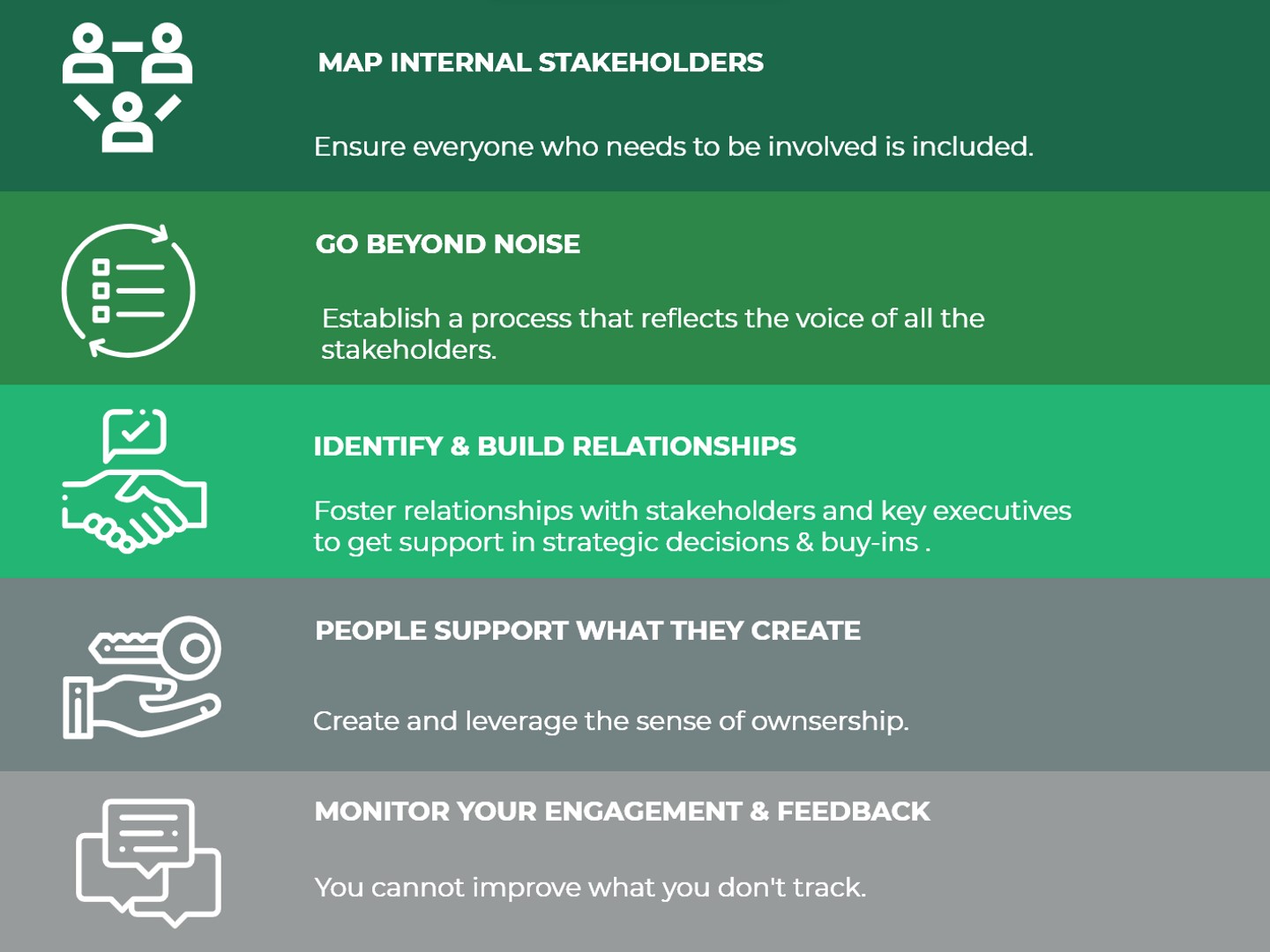 Have you ever wondered why achieving project success often feels uncertain and elusive despite meticulous planning and execution? If you have, you are not alone. Many project managers and teams grapple with this very question, and the answer lies in the power of stakeholder engagement.
Have you ever wondered why achieving project success often feels uncertain and elusive despite meticulous planning and execution? If you have, you are not alone. Many project managers and teams grapple with this very question, and the answer lies in the power of stakeholder engagement.
What if every project you undertake not only meets but exceeds expectations? It may sound too good to be true, but it is entirely within your grasp. In today's ever-evolving business landscape, engaging with stakeholders goes beyond mere checkboxes. It is about forging meaningful connections with those who have a vested interest in the outcome of your project. Whether you are a seasoned project manager or an aspiring enthusiast, mastering stakeholder engagement is your key to achieving goals with ease. In this article, we will delve into the concept of stakeholder engagement, its significance for project success, and practical strategies to effectively engage stakeholders.
What is Stakeholder Engagement?
Stakeholder engagement is the art of actively involving individuals, groups, or organizations that have a stake in your project's success. These stakeholders can be internal, such as employees and management, or external, including customers, suppliers, shareholders, and the wider community. Effectively engaging with stakeholders means establishing open, transparent, and collaborative relationships to address their needs, expectations, and concerns.
According to KPMG, “61% of projects have highly involved sponsors. When stakeholders feel their interests and needs are being considered, they are more likely to support the project.”
Why Does Stakeholder Engagement Matter?
Stakeholder engagement is the lifeblood of successful projects. According to a study by HubSpot, 78% of projects with highly engaged stakeholders are successful, compared to only 40% with low engagement. Such a significant difference emphasizes the importance of making stakeholders an integral part of your project journey.
Whereas a survey conducted by Simplilearn reveals that 81% of projects face challenges due to poor stakeholder management. Failing to engage with stakeholders can lead to misunderstandings, conflicts, and missed opportunities, jeopardizing project outcomes.
The Benefits of Strategic Stakeholder Engagement:
Engaging with stakeholders strategically can lead to numerous benefits for your project, including:
- Enhanced Project Understanding: By engaging stakeholders from the outset, you can gain valuable insights and perspectives, leading to a better understanding of project requirements and objectives.
- Building Consensus: Involving stakeholders in decision-making fosters a sense of ownership and increases the likelihood of achieving consensus on critical project matters.
- Risk Mitigation: Proactively engaging with stakeholders can help you identify potential risks in advance, enabling you to develop effective risk mitigation strategies.
- Resource Allocation: Stakeholder engagement aids in optimizing resource allocation by aligning project priorities with stakeholder expectations.
- Improved Communication: Effective communication with stakeholders promotes transparency and ensures everyone remains informed throughout the project lifecycle.
Tips for Effective Stakeholder Management

Strategies for Engaging with Stakeholders
Now that we understand the importance of stakeholder engagement, let us explore some strategies to implement it successfully:
- Identify and Prioritize Stakeholders: Conduct a thorough stakeholder analysis to identify all relevant individuals and groups. Prioritize them based on their level of influence and interest in your project.
- Understand Stakeholder Needs and Expectations: Engage in dialogues with stakeholders to comprehend their needs, concerns, and expectations from the project. This will help tailor your approach accordingly.
- Clear and Consistent Communication: Maintain open and transparent communication channels to keep stakeholders informed about project progress, challenges, and successes.
- Regular Feedback Mechanisms: Implement feedback loops to receive input from stakeholders at various stages of the project. This helps with course correction and continuous improvement.
- Address Concerns and Conflicts: Actively address any conflicts or concerns raised by stakeholders. Nurturing positive relationships is crucial for project success.
Per PMI, “44% of projects fail because of a lack of alignment between business and project objectives.”
Real-Life Examples of Stakeholder Engagement
Let us look at some real-life examples of successful stakeholder engagement:
Tesla's Charging Infrastructure
Tesla's remarkable success in the electric vehicle market is partially attributed to its effective stakeholder engagement strategy. The company engaged with governments, businesses, and the public to expand its charging infrastructure. By involving various stakeholders, Tesla encouraged the growth of electric vehicles globally.
Procter & Gamble's ‘Connect + Develop’
Procter & Gamble (P&G) embraced stakeholder engagement through its "Connect + Develop" initiative. This open innovation platform invites external stakeholders, including suppliers and customers, to collaborate on product innovation and development. The strategy has enabled P&G to leverage diverse perspectives and expertise, leading to breakthrough innovations.
Starbucks' Ethical Sourcing
Starbucks is renowned for its commitment to ethically sourcing coffee beans. The company actively engages with NGOs, farmers, and customers to ensure sustainable and ethical practices throughout its supply chain. By involving stakeholders, Starbucks has not only enhanced brand loyalty but also contributed positively to sustainability efforts.
Stakeholder Engagement in 2023: Trends and Predictions
Stakeholder engagement is witnessing several noteworthy trends:
- Digital Transformation: Advancements in technology are reshaping stakeholder engagement through digital communication platforms and data-driven insights. Social media, project management tools, and virtual collaboration platforms are becoming vital channels for engaging stakeholders.
- Evolving Environmental Concerns: Stakeholders are increasingly demanding environmentally sustainable practices, pushing businesses to align their projects with eco-friendly initiatives. Companies will need to integrate sustainability into their strategies to maintain stakeholder support.
- Remote Stakeholder Management: With the rise of remote work, project leaders must adapt to engage stakeholders effectively in virtual environments. Video conferencing, webinars, and project assessment surveys are invaluable tools for maintaining meaningful connections with stakeholders.
- Diversity, Equity, and Inclusion (DEI): Stakeholder engagement now emphasizes DEI principles, fostering inclusivity and equal representation within projects. Businesses must ensure that their projects reflect the diverse perspectives of their stakeholders.
Crafting a Stakeholder Engagement Plan
Developing a robust stakeholder engagement plan involves the following steps:
- Defining Objectives: Clearly outline project objectives and how stakeholders contribute to achieving them. This clarity will guide your engagement efforts.
- Mapping Stakeholders: Identify key stakeholders and analyze their interests, expectations, and influence. Understand their motivations and concerns to tailor your approach accordingly.
- Choosing Engagement Methods: Select appropriate channels for engaging stakeholders, such as meetings, surveys, or focus groups. Consider their preferences and the nature of the project.
- Creating a Communication Strategy: Develop a communication plan detailing how and when stakeholders will receive project updates. Be consistent and transparent in your communications.
- Monitoring and Evaluation: Continuously assess stakeholder engagement effectiveness and adapt the plan accordingly. Regularly seek feedback and adjust to enhance engagement.
Conclusion
Stakeholder engagement is the backbone of successful projects, bridging the gap between vision and execution. By proactively involving stakeholders, organizations gain valuable insights, build trust, and foster a collaborative atmosphere. Embracing strategic stakeholder engagement as a core business practice is no longer an option; it is a necessity in today's dynamic business landscape.
As we move forward, stakeholder engagement trends will be pivotal in maintaining a competitive advantage. Organizations that prioritize transparent communication, active involvement, and adaptive strategies will fearlessly drive project success.
How TrueProject’s Proactive Approach Can Help You Drive Project Success
Stakeholder engagement is critical to project success, and TrueProject is the optimal product to help project leaders achieve it. By actively involving stakeholders, project leaders can gain valuable insights, build consensus, mitigate risks, optimize resource allocation, and improve communication.
The TrueProject dashboard offers real-time insights into project progress, performance, and resource allocation, enabling project leaders to make informed decisions. By leveraging TrueProject's predictive intelligence, project leaders can fearlessly drive project success by proactively engaging with stakeholders, aligning project priorities with stakeholder expectations, and fostering a culture of continuous improvement and adaptability.
More information on TrueProject at trueprojectinsight.com

About the Author:
Dale Malcolm is the Director of TrueProject Customer Success with over 30 years of experience spanning software development, consulting, and business process re-engineering across multiple industries and countries. He has excelled in roles ranging from lead architect for data collection systems to database architect for telecom software, and has led various teams in implementing cost-effective and efficient IT solutions, including ERP and Enterprise Architecture practices.
Endnotes
- Melissa Huge. "How to Use a Dashboard for Project Management." Hurree: – Jun 14, 2022. https://blog.hurree.co/how-to-use-a-dashboard-for-project-management
- Stephanie Trovato. "The Complete Guide to Stakeholder Management." HubSpot: April 23, 2023. https://blog.hubspot.com/marketing/stakeholder-management
- Allison Hendricks. "Top 7 Trends for Stakeholder Management in 2023." Simply Stakeholders: (n.d.) https://simplystakeholders.com/stakeholder-management-trends-2023
- Muriel Skusa. "The Ultimate Guide to Stakeholder Management for Your Marketing Projects." Filestage: March 22, 2023. https://filestage.io/blog/stakeholder-management
- GlobeScan Team. "Managing Trust Risk Infographic 4: Advanced Stakeholder Engagement." GlobeScan: February 17, 2017. https://globescan.com/2017/02/27/managing-trust-risk-infographic-4-advanced-stakeholder-engagement
- Srujit Biradawada & Friends (Aarti, Lucy, Laura, Sumer, Vincent, & Joyce). "Tesla: Identifying Stakeholders – Internal and External." Biradawada: August 27, 2020.
- Larry Huston and Nabil Sakkab. "Connect and Develop: Inside Procter & Gamble's New Model for Innovation." Harvard Business Review: March 2006. https://hbr.org/2006/03/connect-and-develop-inside-procter-gambles-new-model-for-innovation
- IvyPanda Team. "Starbuck’s Ethical Relationship with Stakeholders Essay." IvyPanda: June 14, 2019. https://ivypanda.com/essays/starbucks-ethical-relationship-with-stakeholders-essay/





